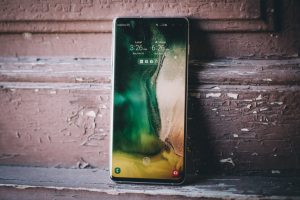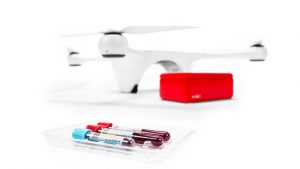Sony’s new flagship Xperia 1 is a skyscraper of a phone. Thanks to its display’s cinema-wide, 21:9 aspect ratio, the Xperia 1 seems even taller than it actually is. It looks like it towers over other phones.
The Xperia 1 is Sony’s latest attempt to reboot its smartphone line, something the company seems to do every few years. This time, the focus is on both movie watchers and movie makers. I’m not sure phone-wielding movie makers are the demographic Sony needs, and even if they are, I’m pretty sure the Xperia 1 isn’t the movie-making device they’re going to want.
The Long and Thin of It
The Xperia 1 is a smooth, waterproof, nearly fingerprint-proof slab of glass just over 8-mm thick. The first thing that hits you when you pick it up is how long and thin it is. The tall, slim body reflects Sony’s notion that this phone is a great way to watch movies. David Lynch, of course, would disagree, but a movie on your phone can be nice when you’re stuck on a long plane flight or commute. But do you want the phone you use every day to be optimized for situations you’re in only occasionally?
Sony
Sony’s definition of “movie” is also preposterously narrow. In the Xperia 1’s world a movie is anything in 21:9 format. While roughly two-thirds of Netflix content is formatted 21:9 (and looks fantastic on this phone), all of YouTube, nearly every television show ever made, and most Android games all have black bars on the Xperia 1. On a regular day, you’ll have a better chance of seeing black bars alongside your video content on the Xperia 1 than on a traditional phone.
That said, the Xperia 1 is not as awkward to use one handed as I thought it would be. There is a one-handed mode you can activate to make it easier. There’s also a side-activated menu that makes it easy to get to your most popular apps without contorting your fingers like a heavy-metal guitarist.
The very long screen is also sometimes useful. For example, you can do a split view to multitask a little easier. But using Gmail with 15 messages stacked at a time felt more overwhelming, not less, than on a normal phone. Seeing more notifications piled up was also more stressful than helpful.
Overall, the longer, thin screen offers no real advantage for all the things you do on your phone when you aren’t watching (or filming) movies.
Your Movie Awaits
The dedicated camera button on the right side works as advertised. Even if the phone is asleep, pressing it will immediately bring it to life and snap an image. This was the single best part of the Xperia 1.
If you do plan to shoot movies with this phone, you can rest easy knowing that its speedy 8-core Snapdragon 855 chipset is up to the task. Sony’s lightly customized Android 9.0 Pie is very snappy. The phone does heat up considerably when shooting 4K video, especially if you’re out in the heat, but my unit never froze up or stopped recording.
As with other Sony phones we’ve looked at recently, this isn’t an all-screen phone. It has a rectangular screen (no notch) with a thin but noticeable bezel at the top and bottom, which hold vital sensors, speakers, and the selfie cam.
The 3,330-mAh battery is disappointing for a phone that seems geared toward some movie binge watching. In my testing, when streaming video from Netflix over Wi-Fi, one film dropped the battery by about 23 percent. There’s enough battery to get you through a coast-to-coast flight, but you’ll want a charge when you get there. The good news is that with 30 minutes of charging you can get the Xperia battery back up to about 50 percent.
The cameras at your disposal are also pretty good, though not particularly inspiring—especially for budding filmmakers. Like most flagship phones in this range, the Xperia 1 has three rear cameras. There’s the main lens, a fisheye-style wide-angle, and a 2X telephoto. All three shoot 12-megapixel images.
While not quite wide enough to call it a true fisheye, the wide-angle lens has some of the same effects, with significant distortion that goes uncorrected by the phone. You can still shoot good photos with it, but you have to watch your angles and horizons or else learn to love the bug-eyed view of the world that it offers. The telephoto offers up to 2X zoom, which is sometimes helpful.
Scott Gilbertson
The primary lens takes sharp photos with true colors and details that hold up well. It’s also excellent at depth of field in portraits and macro-style shots. Unlike the Pixel 3A and many of our favorite Android phones, there is no Night mode, though there is a Scene mode that will lighten nighttime shots. Unfortunately, the results are not the best.
Fingerprints and Sound
The Xperia 1 has a USB-C port at the bottom. Its power button and volume toggles are both on the right side, as is the fingerprint reader.
The fingerprint reader was hit or miss for me, due to its location. It’s in a comfortable spot while you’re holding the phone, and great when it works. Unfortunately, at least a third of the time it didn’t respond at all. But hey, at least that Gorilla Glass coating doesn’t pick up fingerprints as you wildly stab at the side of your phone.
One surprise was the speakers, which are actually pretty good. They really better be in a phone chasing a cinematic experience. And no, they aren’t that good. If you’re serious about your movies, you’ll want to pair this phone with a decent set of headphones, which can help make movie watching fairly immersive, David Lynch not withstanding. At least, until your vibrating phone interrupts it all.
Sony added its Dynamic Vibration feature to the Xperia 1, which vibrates the phone with the song (or movie). Who wants this is unclear to me, and like WIRED editor Jeffrey Van Camp said, it’s a ridiculous gimmick in his review of the Xperia XZ2. Instead of pulling you into a good film, it yanks you out of the music or movie to remind you that, yes, there’s a phone in your hand. We hope this feature will go the way of Sony’s Memory Stick.
What you won’t get is a headphone jack. Ironically, Sony includes a pair of earbuds—some of the worst I’ve used—but no jack. Instead you get a USB-C headphone adapter, because life did not have enough dongles already. If you end up getting the Xperia 1, grab yourself a pair of Bluetooth headphones to go with it.
A Long Screen Isn’t Enough
It’s tough to recommend this $950 phone. On one hand, there’s really nothing terribly wrong with the Xperia 1, but it also isn’t the best at anything. It’s a phone that’s fun to test, great if you get one as a gift, but just too expensive to justify buying. If you really want to create the next cinematic masterpiece, skip Sony’s phone, grab a Pixel 3A, and put the $550 you save toward the Sony Alpha 7S. It will take you places, not hold you back.



